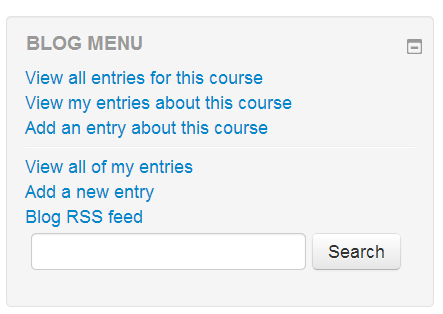Difference between revisions of "Blog settings"
| (3 intermediate revisions by the same user not shown) | |||
| Line 1: | Line 1: | ||
| − | |||
| − | |||
{{Template:Blogs}} | {{Template:Blogs}} | ||
==Enabling / disabling blogs== | ==Enabling / disabling blogs== | ||
| − | Blogs in Moodle are enabled by default. They may be disabled by a site administrator in '' | + | Blogs in Moodle are enabled by default. They may be disabled by a site administrator in ''Site administration > Advanced features'' by setting the blog visibility to 'Disable blog system completely'. |
==My profile settings== | ==My profile settings== | ||
| Line 10: | Line 8: | ||
===Blog entries per page=== | ===Blog entries per page=== | ||
| − | In | + | In your Blog preferences (via the User menu > Preferences) you can set how many blog entries are displayed on a page. The default number of entries is 10. |
==Site administration settings== | ==Site administration settings== | ||
| − | Blogs have additional settings which may be changed by an administrator in '' | + | Blogs have additional settings which may be changed by an administrator in ''Site administration > Appearance > Blog''. |
===Enable blog associations=== | ===Enable blog associations=== | ||
[[Image:Blog menu block.png|frame|Blog menu block on an assignment page]] | [[Image:Blog menu block.png|frame|Blog menu block on an assignment page]] | ||
| − | If blog associations are enabled, users can blog about their course | + | If blog associations are enabled, users can blog about their course using the 'Add an entry about this course' link in the [[Blog menu block]]. |
| − | |||
| − | |||
| − | |||
| − | |||
| − | |||
| − | |||
===Blog visibility=== | ===Blog visibility=== | ||
This setting allows you to restrict the level to which user blogs can be viewed on this site. Note that they specify the maximum context of the VIEWER not the poster or the types of blog posts. Blogs can also be disabled completely if you don't want them at all. | This setting allows you to restrict the level to which user blogs can be viewed on this site. Note that they specify the maximum context of the VIEWER not the poster or the types of blog posts. Blogs can also be disabled completely if you don't want them at all. | ||
| − | |||
| − | |||
| − | |||
| − | |||
===Enable external blogs=== | ===Enable external blogs=== | ||
| Line 59: | Line 47: | ||
* [[Capabilities/moodle/blog:viewdrafts|View draft blog entries]] | * [[Capabilities/moodle/blog:viewdrafts|View draft blog entries]] | ||
* [[Capabilities/moodle/user:readuserblogs|See all user blogs]] | * [[Capabilities/moodle/user:readuserblogs|See all user blogs]] | ||
| − | |||
| − | |||
The [[Blogger role]] may be used to limit blogging to specific users only. | The [[Blogger role]] may be used to limit blogging to specific users only. | ||
Latest revision as of 14:50, 11 June 2021
Contents
Enabling / disabling blogs
Blogs in Moodle are enabled by default. They may be disabled by a site administrator in Site administration > Advanced features by setting the blog visibility to 'Disable blog system completely'.
My profile settings
Blog entries per page
In your Blog preferences (via the User menu > Preferences) you can set how many blog entries are displayed on a page. The default number of entries is 10.
Site administration settings
Blogs have additional settings which may be changed by an administrator in Site administration > Appearance > Blog.
Enable blog associations
If blog associations are enabled, users can blog about their course using the 'Add an entry about this course' link in the Blog menu block.
Blog visibility
This setting allows you to restrict the level to which user blogs can be viewed on this site. Note that they specify the maximum context of the VIEWER not the poster or the types of blog posts. Blogs can also be disabled completely if you don't want them at all.
Enable external blogs
Enables users to specify external blog feeds. Moodle regularly checks these blog feeds and copies new entries to the local blog of that user.
External blog cron schedule
How often Moodle checks the external blogs for new entries. By default it is 24 hours.
Maximum number of external blogs per user
By default, the number of external blogs each user is allowed to link to their Moodle blog is 1.
Enable comments
Blog comments are enabled by default, though may be disabled if required.
Blog capabilities
- Create new blog entries
- Edit and manage entries
- Edit and manage external blogs
- Search blog entries
- View blog entries
- View draft blog entries
- See all user blogs
The Blogger role may be used to limit blogging to specific users only.
eu:Sarrera_gehitu_blogean de:Blog konfigurieren fr:Ajouter/modifier un blog es:Configuraciones del blog
